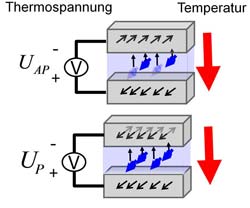Channelling waste heat in microprocessors in new directions

Schematic diagram of how thermopower in the magnetic tunnel junction is switched via antiparallel (AP) or parallel (P) magnetisation.<br>Göttingen University<br>
An international team of researchers at the Universities of Göttingen, Bielefeld and Giessen, along with the Massachusetts Institute of Technology (MIT) in the USA, has now developed a new method that influences the electron’s thermopower in the tunnel junction by directly changing magnetisation. This way, they can control the conversion of heat into electrical energy. The results may contribute to the future development of novel, economical microprocessors.
DFG funds additional collaborative research to the tune of one million euros
Spin caloritronics is a new area of research: What happens when you heat up a magnet? When a material is heated, the temperature differential in the electrons generates an electrical voltage known as thermopower or the Seebeck effect. Electronic components made of magnetic materials – consisting of two magnetic layers separated by a thin oxide film only a few atomic layers thick – for example, are used as reading heads for hard drives. Current research focuses on the use of such magnetic tunnel junctions as nonvolatile memory elements in processors where data are preserved without an energy supply. An international team of researchers at the Universities of Göttingen, Bielefeld and Giessen, along with the Massachusetts Institute of Technology (MIT) in the USA, has now developed a new method that influences the electron’s thermopower in the tunnel junction by directly changing magnetisation. This way, they can control the conversion of heat into electrical energy. The results may contribute to the future development of novel, economical microprocessors and were published on Sunday, July 24, 2011 in the online issue of “Nature Materials“.
Elementary particles, many atomic nuclei and atoms with certain electron configurations have what is called spin – defined as the rotation of a body around its own axis. That enables alternative, spin-based methods of electronic data processing – called “spin electronics“. New synergies are created by merging the fields of spin electronics and the energy conversion of novel materials. A Japanese team of researchers recently showed that tunnel barriers enable thermal spin injection into the semiconductor silicon.
The team of researchers around the Göttingen physicist Professor Markus Münzenberg has now used laser power to heat up magnetic tunnel junctions and thereby discovered a novel effect: Thermopower was created during spin transport through the thin oxide layer (tunnel barrier) the heated up electrons traverse. They could raise or lower the thermopower by changing the magnetisation. In doing so, they influenced the thermopower of the whole magnetic tunnel junction. They predict that a change in thermopower of up to 1000 % is possible. This newly discovered effect involving the switching of thermopower in magnetic tunnel junctions was dubbed the magneto-Seebeck effect. “This has released the potential for us to locally control energy conversion in the tiniest of junctions and, in the future, for example, to channel back into the computer system the energy generated in microprocessors that previously went unutilised, or computer chips working with waste heat only” said Prof. Münzenberg, who leads a research group at the 1st Institute of Physics of Göttingen University. Since July 2011, the collaborative research of these working groups at the three German universities has been part of the priority programme titled “Spin Caloric Transport (SpinCat) – SPP 1538“, funded by the German Research Foundation (DFG) to the tune of over one million euros.
Original publication:
M. Walter, J. Walowski, V. Zbarsky, M. Münzenberg et al, Seebeck effect in magnetic tunnel junctions, Nature Materials, published online 24 July 2011, DOI: 10.1038/NMAT3076
Contact address:
Professor Markus Münzenberg
Georg-August University Göttingen
Faculty of Physics – Physical Institute I
Friedrich-Hund-Platz 1, 37077 Göttingen
Phone (0551) 39-7604, Fax (0551) 39-12229
E-mail: mmuenze@gwdg.de
Media Contact
More Information:
http://www.uni-goettingen.de/de/99100.htmlAll latest news from the category: Power and Electrical Engineering
This topic covers issues related to energy generation, conversion, transportation and consumption and how the industry is addressing the challenge of energy efficiency in general.
innovations-report provides in-depth and informative reports and articles on subjects ranging from wind energy, fuel cell technology, solar energy, geothermal energy, petroleum, gas, nuclear engineering, alternative energy and energy efficiency to fusion, hydrogen and superconductor technologies.
Newest articles

Bringing bio-inspired robots to life
Nebraska researcher Eric Markvicka gets NSF CAREER Award to pursue manufacture of novel materials for soft robotics and stretchable electronics. Engineers are increasingly eager to develop robots that mimic the…

Bella moths use poison to attract mates
Scientists are closer to finding out how. Pyrrolizidine alkaloids are as bitter and toxic as they are hard to pronounce. They’re produced by several different types of plants and are…

AI tool creates ‘synthetic’ images of cells
…for enhanced microscopy analysis. Observing individual cells through microscopes can reveal a range of important cell biological phenomena that frequently play a role in human diseases, but the process of…





















